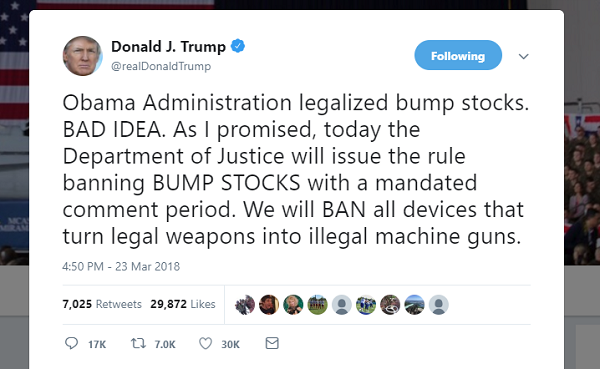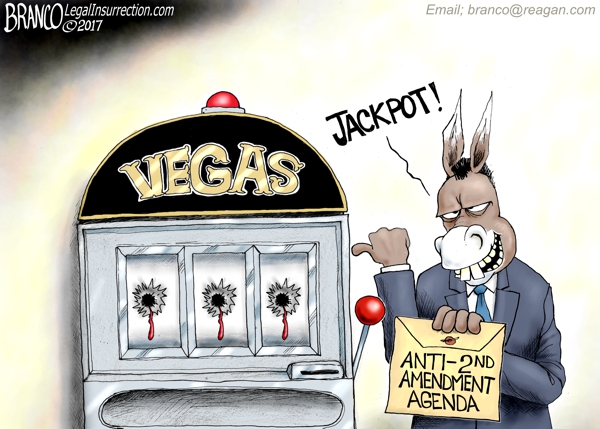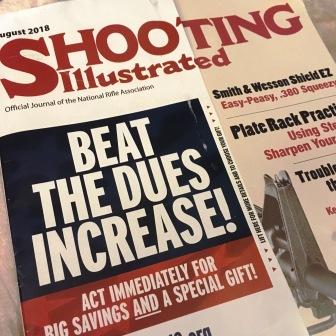Legal Challenges to Bump Stock Ban Begin Rolling In
 As reported Tuesday and discussed on the GunLink Forums, the Department of Justice this week issued a new regulation reversing the BATFE’s longstanding position on bump stock devices. This regulation modifies the meaning of certain words and changes the codified definition of machine gun such that it now includes language inclusive of bump stocks.
As reported Tuesday and discussed on the GunLink Forums, the Department of Justice this week issued a new regulation reversing the BATFE’s longstanding position on bump stock devices. This regulation modifies the meaning of certain words and changes the codified definition of machine gun such that it now includes language inclusive of bump stocks.
This reclassification leads to a situation faced by many hundreds of thousands of owners of such devices whereby they must now either destroy or surrender to the BATFE their lawfully purchased property or become overnight felons in possession of illegal, unregistered machine guns.
No doubt worse than the fact that they must now hand over their property – purchased in good faith with assurance from the BATFE that the device was, in fact, not a machine gun – without compensation, is the manner in which the regulation came about.
To be certain, the regulation is causing an uproar among factions of the firearms community with talk about violations of everything from Article I of the US Constitution’s prohibition on ex post facto laws to various and sundry elements of the Bill of Rights to include the 2nd, 4th, 5th, 9th, and 10th Amendments.
The Cato Institute published a piece rightly stating that “this regulation is not an attempt to clarify a vague law, but to seize political expediency to expand the power of the executive,” continuing that they may reserve their “right to intervene in the coming litigation.”
It should come as no surprise that the first legal challenges to the Bump Stock Ban were put into motion just a few short hours after the announcement that it had been inked by Acting Attorney General Matthew Whitaker given that the opening shots in this legal battle were fired by some of the more prolific opposition to the change since its early stages. Continue reading
Dianne Feinstein Statement on Bump Stock Ban

In absurd reaction to ludicrous regulation, California Democratic Senator Dianne Feinstein issued the following statement regarding the administration’s new ban which declares the accessory to be a “machine gun.”
For readers not familiar with bump stocks, the device is a firearm accessory – a shoulder stock that is loose fitting enough to allow a rifle equipped with one about half an inch of front-to-rear play. When used as intended, the user pulls forward on the firearm (while the stock stays rearward) – pulling the trigger into the shooter’s finger causing it to fire. The recoil impulse of the round going off causes the rifle to move rearward, resetting the trigger. Subsequent, or continued, forward pulls on the firearm repeat the process, allowing for rapid fire as the trigger is quickly pulled multiple times, once for each shot, in fast semi-auto fire. Oh, the humanity… pulling the trigger quickly!
Below is Senator Feinstein’s hand-wringing statement:
“Bump stocks allow semi-automatic weapons to fire like automatic weapons, making guns like the AR-15 even more deadly. Banning bump stocks has widespread support and it’s encouraging to see the Trump administration take action on this commonsense gun safety proposal.
“However, Congress must pass legislation to ensure a ban on bump stocks and other similar devices is protected from legal challenges.
“Until March 2018, ATF maintained that bump stocks could not be banned through administrative action. Legislation is necessary to ensure a ban is implemented and regulations are not tied up in court.
“Gun Owners of America has already announced its intent to sue to block the ban from taking effect. Congress simply must act to get these dangerous devices off the streets, and I will be reintroducing my bill to ban them early next year.”
Acting AG Signs New Bump Stock Ban
Devices Must Be Destroyed Within 90 Days of Rule Being Published
 After months of speculation on whether such a measure could be taken under an ostensibly pro-RKBA administration, Acting Attorney General Matthew Whitaker signed a new rule today that classifies “bump stocks” as machine guns and bans their possession. The rule, set to take effect 90 days after it is published in the Federal Register – which is expected to happen this Friday – would require current owners of the devices to destroy them.
After months of speculation on whether such a measure could be taken under an ostensibly pro-RKBA administration, Acting Attorney General Matthew Whitaker signed a new rule today that classifies “bump stocks” as machine guns and bans their possession. The rule, set to take effect 90 days after it is published in the Federal Register – which is expected to happen this Friday – would require current owners of the devices to destroy them.
The BATFE had previously concluded that such devices were unable to be federally regulated as such because they are simply an accessory part. Following the Mandalay Bay attack in October 2017 in which the attacker allegedly used weapons equipped with such devices, President Trump prompted the DOJ to revisit the matter. AG Jeff Sessions introduced the proposed legislation in March 2018.
The new rule inaccurately concludes that these devices allow a “shooter of a semiautomatic firearm to initiate a continuous firing cycle with a single pull of the trigger,” making it a machine gun. Generally, under current regulations, possession or transfer of a machine gun manufactured prior to May 19, 1986 – the date on which the Firearms Owners Protection Act (and the Hughes Amendment thereof) went into effect.
The complete Final Rule can be read here. The summary of the rule reads as follows (emphasis added):
The Department of Justice is amending the regulations of the Bureau of Alcohol, Tobacco, Firearms, and Explosives (ATF) to clarify that bump-stock-type devices […] are “machineguns” as defined by the National Firearms Act of 1934 and the Gun Control Act of 1968 because such devices allow a shooter of a semiautomatic firearm to initiate a continuous firing cycle with a single pull of the trigger. Specifically, these devices convert an otherwise semiautomatic firearm into a machinegun by functioning as a self-acting or self-regulating mechanism that harnesses the recoil energy of the semiautomatic firearm in a manner that allows the trigger to reset and continue firing without additional physical manipulation of the trigger by the shooter. Hence, a semiautomatic firearm to which a bump-stock-type device is attached is able to produce automatic fire with a single pull of the trigger. With limited exceptions, the Gun Control Act, as amended, makes it unlawful for any person to transfer or possess a machinegun unless it was lawfully possessed prior to the effective date of the statute. The bumpstock-type devices covered by this final rule were not in existence prior to the effective date of the statute, and therefore will be prohibited when this rule becomes effective. Consequently, under the final rule, current possessors of these devices will be required to destroy the devices or abandon them at an ATF office prior to the effective date of the rule.
The BATFE sought public comment on the proposal, receiving upward of 100,000 comments, although passage of such a rule seems to have been a foregone conclusion with direction straight from the White House. Given the Second and Fifth Amendment concerns surrounding the issue and the time frame for it to go into effect, we expect to see a number of legal challenges to the rule.

Branco: Same Left Strategy, Different Day
“The Left can’t let a mass murder go to waste, and immediately move to exploit the tragedy in Los Vegas.” Political Cartoon by A.F. Branco

NRA Membership Dues Scheduled for Another Imminent Increase
 CLICK HERE to join or renew today at discounted rates
CLICK HERE to join or renew today at discounted rates
If you are a current member who retrieved your National Rifle Association publication, such as Shooting Illustrated, American Rifleman, American Hunter, or America’s First Freedom from your mailbox, or if you visited the NRA website, you were likely greeted by the news that dues are set to increase again in the very near future.
The half-cover of the August 2018 issue of NRA magazines (sent mid-July) posits that the increase is set to take place on August 1st.
You may recall that the gun rights lobbying group’s dues also increased in 2016 in the run-up ahead of the big push during the presidential election campaign. You may also recall that the eventual increase came only after the organization kicked the can down the road a number of times, issuing the date of the increase only to keep pushing it back several times before the inevitable price hike. While that may happen again with this increase, it also may very well not. We don’t have any insider information about that, but we will share whatever we find out as soon as we know.
Even though this is the second time in as many years that price increases have taken place, NRA touts the fact that dues increases are few and far between. The inside jacket of the magazine reads: “On August 1, 2018, NRA dues will increase for only the second time in more than 20 years. There’s simply no other way we can stop a gun-ban takeover of the U.S. Congress and save our Second Amendment Rights. But you can beat the dues increase by renewing today.”
In addition to beating the dues increase, you can also get extra savings on your NRA membership dues here. Even after the increase, this link will provide savings off of the normal new member and renewal fees, although the prices there will automatically adjust once the increase goes into effect.
Judge Brett Kavanaugh Has Earned NRA Members’ Support
 NRA members can feel confident throwing their enthusiastic support behind President Donald Trump’s nomination of Judge Brett Kavanaugh to the U.S. Supreme Court. Throughout his time on the bench, Judge Kavanaugh has demonstrated deep respect for the Second Amendment as construed in Justice Antonin Scalia’s landmark decision in District of Columbia v. Heller. Moreover, his record on the Second Amendment is well established. As Second Amendment scholar and University of Denver Law Professor Dave Kopel wrote earlier this week, “No nominee to the U.S. Supreme Court has had such a detailed record on Second Amendment as does Brett Kavanaugh.”
NRA members can feel confident throwing their enthusiastic support behind President Donald Trump’s nomination of Judge Brett Kavanaugh to the U.S. Supreme Court. Throughout his time on the bench, Judge Kavanaugh has demonstrated deep respect for the Second Amendment as construed in Justice Antonin Scalia’s landmark decision in District of Columbia v. Heller. Moreover, his record on the Second Amendment is well established. As Second Amendment scholar and University of Denver Law Professor Dave Kopel wrote earlier this week, “No nominee to the U.S. Supreme Court has had such a detailed record on Second Amendment as does Brett Kavanaugh.”
The bulk of Judge Kavanaugh’s record on the Second Amendment comes from his 2011 dissent in Heller v. District of Columbia, or Heller II. The case concerned a challenge to Washington, D.C.’s ban on commonly-owned semi-automatic rifles and the city’s onerous firearms registration regime.
Under much constitutional precedence, courts are tasked with interpreting a law’s impact on a given right by using a system of tiered balancing tests, where they weigh the government’s interest against the right at stake. Fundamental rights are tested under a strict scrutiny standard, whereby the government has the burden of showing that a given restriction serves a compelling government interest and is the least restrictive means to further that interest. Lesser infringements are tested using intermediate scrutiny, which requires a restriction to serve an important government interest and that the means of doing so are substantially related to the interest. All laws are subject to the rational basis test, whereby a given restriction must be at least rationally related to a legitimate government purpose. Continue reading









